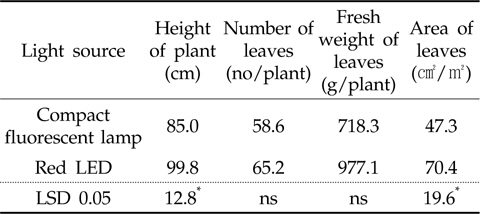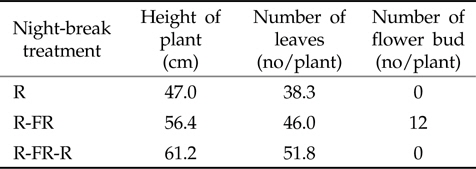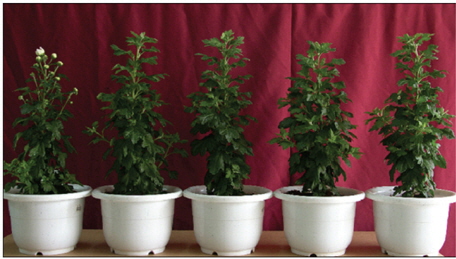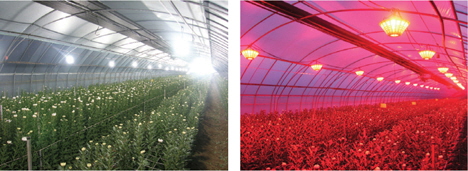



적색광을 이용한 국화의 일장연장 처리기술을 개발하기 위하여 국화의 개화억제를 위한 적색광 강도를 구명하고 생육에 대한 영향을 검토하였다. 국화는 적색광에 의한 파야처리로 개화가 억제되었고 연속된 초적색광 처리로 개화하여 개화의 광가역적 반응을 나타냈다. 인공광 생육실 환경하에서 적색광 1.4 μmol/m2/s (PAR) 로 일장연장 처리시 국화의 개화가 완전히 억제되었다. 적색광 1.4 μmol/m2/s 처리는 관행의 전구식형광등 50 Lux 처리와 같이 국화의 개화를 억제시켰다. 적색 LED를 이용한 일장연장 처리로 관행의 전구식형광등 처리보다 국화의 초장은 17 %, 엽면적은 48 % 유의하게 증가하였고 엽수와 생체중은 각각 11 %, 36 % 증가하는 경향이었다.
The incandescent bulb and compact fluorescent lamp are widely using as a light sources for daylength extension of chrysanthemum. But, these light sources consume a lot of electricity and have short longevity. A light-emitting diode (LED) is a semi conductor light source. LEDs have many advantages over incandescent light sources including lower energy consumption, longer lifetime. In this study, we investigated the intensity of red light to control flowering of chrysanthemum (
The red (660 nm) and far-red (730 nm) light were irradiated subsequently to investigate photo-reversible flowering responses of chrysanthemum. The flowering of chrysanthemum was inhibited by night interruption with red light but subsequently irradiated far-red light induced the flowering of chrysanthemum. This photoreversibility, reversion of the inductive effect of a brief red light pulse by a subsequent far-red light pulse, is a property of photo responses regulated by the plant photoreceptor phytochrome B. Four different intensity of red light of 0.7, 1.4, 2.1, and 2.8 μmol/m2/s (PAR) were irradiated at growth room in order to determine the threshold for floral inhibition of chrysanthemum. Over 1.4 μmol/m2/s of the red lights irradiated chrysanthemums were not flowered. The plant length, fresh weight, number of leaves, and leaf area of chrysanthemum irradiated with red light were increased by 17%, 36%, 11%, and 48%, respectively, compared to those of compact fluorescent lamp.
The red light and subsequential far-red light showed that the photoreversibility on flowering of chrysanthemum. The red light (1.4 μmol/m2/s of red LEDs) and white light (50 Lux of compact fluorescent lamp) have the same effect on inhibition of flowering in chrysanthemum. Additionally, the red light increased the plant height and dry weight of chrysanthemum.
신속하고 균일하고 예측이 가능한 개화는 원예식물 재배시 중요한 요인이다. 원예작물의 개화시기를 조절하면 출하시기를 조절할 수 있고 연중생산이 가능하게 된다 (Armitage and Laushaman, 1989). 일장은 식물의 생장과 개화를 조절하며, 식물의 개화반응은 밤 길이에 따라 분류할 수 있다(Thomas and Vince-Prue, 1997). 국화, 들깨와 같은 단일성식물의 화아형성과 개화는 장야(단일) 조건에서 촉진되고 (Wilkins
원예재배 농가들은 일몰 후 또는 밤의 중간에 인공광원을 켜 주어 단일성식물과 장일성식물의 개화를 조절한다 (Mattson and Erwin, 2005; Yamada
백열등 (Cathey
단일성식물은 적색광의 파야처리로 개화가 억제되고 연속된 초적색광 처리로 파야처리가 무효화되므로 단일처리의 광은 Pfr형 파이토크롬의 형성에 의존적이다(Taiz and Zeiger, 2006). 적색광은 국화와 같은 단일성식물의 일장연장에 의한 개화조절에 효율이 높으나 백열등, 형광등, 고압나트륨램프등으로 적색광을 조명하기는 곤란하다.
LED (Light-Emitting Diode)는 단일한 광파장을 방출하는 반도체 광원으로 원예작물의 개화조절을 위해 특정한 광파장을 선택적으로 조명해 줄 수 있는 이점이 있다. 또한 LED는 전구식형광등이나 백열등 보다 전기에너지를 적게 소비하고 수명이 길다. 그러나 실용적으로 사용될 수 있는 적정한 적색광 강도는 검토된 바 거의 없다. 따라서 본 연구는 적색 LED를 이용한 국화의 일장연장 처리기술을 개발하기 위하여 국화의 개화억제를 위한 적색광 강도를 구명하고 생육에 대한 영향을 검토하기 위해 수행하였다.
본 연구는 2007년 수원시에 소재한 국립농업과학원 시험 포장에서 수행하였다. 적색광과 초적색광의 개화조절 효과를 검토하기 위해 1/5,000a 와그너 포트에 원예용 상토(바로커상토, 서울바이오)를 균일하게 충진한 후 국화 (
적색광 강도별 국화의 개화억제 효과를 검토하기 위하여 인공광 생육실에서 1/5,000a 와그너 포트에 국화를 삽목한 후 재배하며 적색광을 처리하였다. 인공광 생육실의 온도는 주/야 25℃로 유지하였고 기본 생육을 위한 광원은 메탈할 라이드 램프를 이용하여 PAR (Photosynthetic Active Radiation) 500 μmol/m2/s 강도로 오전 6시 부터 오후 5시까지 11시간 동안 점등하여 무처리구의 기본일장이 11시간으로 단일상태를 유지하도록 하였다. 적색광을 이용한 일장연장 처리구는 메탈할라이드 램프가 소등된 직후 자체 제작한 적색 LED 장치 (200×6×3 cm)를 이용하여 오후 5시 부터 10시 까지 5시간 동안 점등되어 일장시간이 16시간이 되도록 처리하였다. 적색광은 각각 PAR 0.7, 1.4, 2.1, 2.8 μmol/m2/s 강도로 처리하여 재배하며 국화의 개화반응, 생육특성 등을 조사하였다. 각 처리구의 시험포트는 자동관수 장치를 설치하여 동일한 수분상태를 유지하였으며 광 차단판을 설치하여 인접 광의 간섭이 없도록 하였다. 각 처리구별 적색광 강도는 광센서 SKR-110 (Skyeinstruments, UK)를 이용하여 측정하였다. 광센서 SKR-110의 측정범위는 400∼700nm 였다.
일장연장 처리의 광원별 국화의 개화와 생육반응을 검토하기 위해 비닐하우스에 국화를 정식한 후 6월 1일 부터 11월 20일까지 재배하며 수행하였다. 일장연장 처리는 전구식 형광등과 적색 LED를 이용하여 각각 오후 7시 부터 12시까지 5시간 동안 일장연장 처리하였다. 전구식형광등은 50 Lux, 적색광은 PAR 1.4 μmol/m2/s 강도로 처리하였다. 일장연장 처리 후 국화의 개화와 생육특성 등을 조사하였다. 적색광 처리구의 광 강도는 광센서 SKR-110 (Skyeinstruments, UK)를 이용하여 측정하였다. 광센서 SKR-110의 측정범위는 400∼700 nm 였다. 통계분석은 R 통계패키지 (Ver 2.3)를 사용하였다.
국화 개화의 광가역성을 검토하기 위하여 적색광과 초적색광을 이용하여 파야처리 후 국화의 개화와 생육반응을 조사한 결과는 Table 1과 같다. 적색광으로 15분간 파야처리한 R 처리구는 국화의 개화가 억제되었고, 적색광 처리 직후 초적색광을 처리한 R-FR 처리구는 개화되었다. 또 적색광, 초적색광, 적색광을 순차적으로 처리한 R-FR-R 처리구는 R 처리구와 같이 개화하지 않아 국화는 개화의 광가역성을 나타냈다. R-FR 처리구는 개화되어 적색광에 의한 파야처리구 보다 국화의 엽수는 27 %, 잎 생체중은 57 %, 엽면적은 72 % 감소하였다.

Red and Far-red light reversibility of a night break on flowering and growth characteristics in chrysanthemum.
Table 1의 결과는 Thomas과 Vince-Prue (1997)의 단일성식물인 도꼬마리 (
국화의 개화억제를 위한 한계 적색광 강도를 검토하기 위 하여 일몰후 5시간 동안 적색광을 강도별로 처리한 후 국화 의 개화와 생육특성을 조사한 결과는 Table 2와 Fig. 1과 같다. 국화는 적색광 0.7 μmol/m2/s 처리구에서 개화가 억제되는 경향이었으나 화아 (flower bud)가 1개 출현하였다. 국화는 적색광 1.4 μmol/m2/s 과 2.1, 2.8 μ mol/m2/s 처리구는 전혀 개화하지 않았다. 따라서 국화의 개화억제를 위한 적색광의 한계강도는 1.4 μmol/m2/s로 판단된다. Matthew 등 (2009)은 고압나트륨램프를 이용한 국화의 순환전조시 개화억제를 위한 한계강도는 2.4 μmol/m2/s 이라 했다. Cathey 과 Borthwick (1961)는 백열전구를 이용한 순환전조시 국화의 개화 지연을 위한 한계강도는 1.1μmol/m2/s이라 했다.

Flowering and growth characteristics affected by red light intensities for daylength extension in chrysanthemum.
Armitage과 Laushaman (1989)은 Velvet sage (
Thomas과 Vince-Prue (1997)는 단일성식물은 파야처리하면 단야조건이 유기되어 개화하지 않고 영양생장을 계속하며 이 반응에는 적색광이 가장 유효하다고 하였다. 또 파이토크롬은 초적색광 흡수형인 Pr형과 적색광 흡수형인 Pfr 형태로 존재하며 가역적반응을 유도하는데 밤 동안에 Pfr형 파이토크롬은 Pr형으로 전환되고 Pfr형 파이토크롬이 한계치 이하로 감소되면 단일성식물의 개화가 유도된다고 하였다.
따라서 광원별로 국화의 개화한계 광강도가 다른 것은 광원별로 파장분포가 상이하고 이에 따라 적색광의 강도가 다르기 때문으로 추정된다.
국화의 개화억제를 위한 한계 적색광 강도를 검토하기 위해 적색광을 강도별로 처리한 후 국화의 개화와 생육특성을 조사한 결과 국화의 초장과 엽면적은 적색광 2.8 μmol/m2/s 처리구에서 가장 컸고 단일조건인 무처리구는 개화되어 엽생체중과 엽면적이 적색광 처리구 보다 감소하였다.
국화에 대한 적색 LED의 일장연장 효과를 검토하기 위해관행의 전구식형광등과 적색 LED를 이용하여 일장연장 처리 후 국화의 개화와 생육특성을 조사한 결과는 Table 3과 같다.

Growth characteristics affected by different light sources for daylength extension in chrysanthemum
적색 LED 처리구는 관행의 전구식형광등 처리구와 같이 국화가 개화하지 않고 영양생장을 지속하였다. 전구식형광등과 적색 LED 처리구의 초장과 엽면적은 유의한 차이를 나타내어 적색 LED 처리구는 전구식형광등 처리구 보다 국화의 초장이 17 %, 엽면적은 48 % 컸다. 국화의 엽수와 생체중은 유의한 차이는 없었으나 적색 LED 처리구가 전구식형광등 처리구 보다 엽수는 11 %, 엽생체중은 36 % 증가하는 경향이었다.
이와같이 적색 LED 처리구의 국화의 초장과 엽면적이 전구식형광등 처리구 보다 증가한 것은 적색광에 의한 광합성 촉진효과와 Pfr형 파이토크롬 의 작용에 의한 것으로 추정된다. 따라서 적색광의 생리작용과 효과에 관한추가적인 연구가 필요하다고 판단된다.
Saebo 등 (1995)은 적색광은 광합성 기구의 발달에 중요하고 몇몇 식물종에서는 광합성 산물이 잎 이외의 기관으로 이동하는 것을 억제하여 잎에 전분의 축적이 증가되도록 한다고 하였다. Kasperbauer과 Hamilton (1984)은 적색광을 처리한 담배잎은 그라나가 많고 전분립의 크기가 크다고 하였다. Higuchia 등 (2012)은 적색광으로 파야처리시 국화의 개화는 완전히 억제되고 국화의 엽수는 적색광 파야처리가 청색광이나 초적색광 처리보다 많았다고 하였다.
Fig. 2는 국화 시험포장에서 적색 LED와 관행의 전구식 형광등을 이용해 일장연장 처리하는 전경이다.




